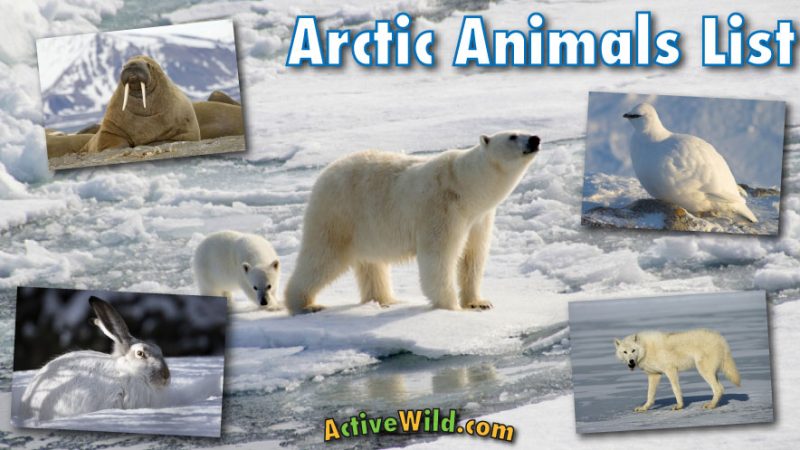The Arctic is a land of extreme cold, harsh winds, and perpetual ice, making it one of the most inhospitable places on Earth. However, it is also home to some of the most extraordinary and resilient creatures that have adapted to survive in these challenging conditions. From towering predators to the smallest creatures that seem out of place in such a harsh environment, the animals in the Arctic are truly remarkable. In this article, we’ll take a closer look at 10 of these incredible species that exist in the frozen north, each of them uniquely adapted to the Arctic’s frigid environment. Discovering these animals in Arctic will change your perspective on life in such extreme conditions.
Polar Bear: The Apex Predator of the Arctic
Perhaps the most iconic of all animals in the Arctic, the polar bear is the ultimate predator in this icy landscape. Known for their thick fur and a layer of fat to insulate them from the extreme cold, polar bears are built for survival in the Arctic’s unforgiving conditions. These apex predators primarily hunt seals, which they catch by waiting near breathing holes in the ice. As the climate changes, however, polar bears are increasingly at risk, with melting sea ice pushing them to travel longer distances in search of food. The survival of such animals in the Arctic is becoming more precarious due to global warming.
Arctic Fox: The Master of Camouflage
The Arctic fox is another fascinating species that thrives in the frozen north. Unlike many animals in the Arctic, the Arctic fox has a thick coat of fur that changes color with the seasons—white during winter and brown in summer. This adaptation allows it to blend seamlessly into its surroundings, whether it’s snow-covered or rocky tundra. Arctic foxes are known to hunt small mammals like lemmings and birds, and they are skilled scavengers, often feeding on the leftovers of larger predators like the polar bear. Their incredible camouflage is one of the most defining features of these animals in Arctic.
Narwhal: The Unicorn of the Sea
The narwhal is one of the most mysterious and intriguing animals in the Arctic. Often referred to as the “unicorn of the sea,” the narwhal is known for its long, spiral tusk that can reach lengths of up to 10 feet. This tusk, which is actually an elongated tooth, is believed to have sensory capabilities, helping narwhals navigate the icy waters of the Arctic. These whales are found in the waters around Greenland, Canada, and Russia and are often seen in pods of up to 20 individuals. The existence of narwhals adds to the mythical allure of animals in Arctic.
Snowy Owl: Silent Hunter of the Arctic
The snowy owl is a majestic bird that calls the Arctic home. With its distinctive white feathers and piercing yellow eyes, the snowy owl is a master of stealth in the snowy landscapes. These owls hunt at night, preying on small mammals like lemmings and voles. Their ability to fly silently through the night air, combined with exceptional vision, makes them highly effective hunters in the Arctic’s dim light. Snowy owls are also known to migrate southward during the winter months in search of more abundant food sources. This migration pattern is one of the fascinating aspects of animals in the Arctic.
Beluga Whale: The Arctic’s “Canary of the Sea”
Beluga whales are known for their white skin and high-pitched, melodic vocalizations, which have earned them the nickname “canary of the sea.” These social whales are found in the icy waters of the Arctic and are often seen in large groups, called pods. Belugas are highly intelligent and communicate with each other through a wide range of sounds. Their ability to adapt to the freezing waters is aided by a thick layer of blubber, which insulates them and helps regulate their body temperature. Their unique vocalizations make them one of the most fascinating animals in the Arctic.
Walrus: The Majestic Ice-Lover
The walrus is one of the largest animals in Arctic, and it has a distinct appearance with its long tusks and thick, wrinkled skin. These massive mammals are found in the icy waters around the Arctic, where they haul themselves onto sea ice to rest. Walruses are highly social creatures and often congregate in large groups on the ice. They primarily feed on mollusks and other bottom-dwelling creatures, using their sensitive whiskers to detect food on the ocean floor. Their tusks are used for hauling out of the water, fighting, and even helping them break through ice to reach open water. Walruses are among the most iconic animals in the Arctic.
Arctic Hare: The Survivor of the Tundra
The Arctic hare is a resilient species that thrives in the harshest parts of the Arctic. Known for its large, powerful legs and thick white fur, the Arctic hare is well-adapted to life in the tundra. These hares can survive extreme temperatures by burrowing into the snow for shelter and maintaining a high metabolism. They are herbivores, feeding on mosses, grasses, and other plants that are able to survive in the frozen ground. In winter, their fur changes to white, helping them blend in with the snowy environment. The Arctic hare is an example of the incredible adaptation of animals in the Arctic.
Musk Ox: The Tank of the Arctic
Musk oxen are large, shaggy mammals that are perfectly suited to the Arctic’s harsh conditions. With their thick coats and strong horns, musk oxen are well-equipped to survive freezing temperatures and fierce winds. These herbivores graze on grasses, mosses, and other tundra plants. Musk oxen are known for their impressive social structure, living in tight-knit herds for protection against predators. Their horns are used in defense and for establishing dominance within the herd. Musk oxen are just another example of the tough and resilient animals in the Arctic.
Greenland Shark: The Mysterious Deep-Dweller
The Greenland shark is one of the most mysterious animals in the Arctic, dwelling in the deep, cold waters around Greenland and Canada. These slow-moving sharks are known for their incredible longevity, with some individuals living for over 400 years, making them one of the longest-living vertebrates on Earth. Greenland sharks are opportunistic feeders, preying on fish, seals, and even polar bears that fall into the water. Due to their slow metabolism and the cold waters they inhabit, they are incredibly resilient to the harsh Arctic conditions. The Greenland shark adds an element of intrigue to the list of animals in Arctic.
Arctic Tern: The Champion Migrant
The Arctic tern is a small seabird known for its incredible migratory journey. These birds are the longest migrators in the animal kingdom, traveling between the Arctic and the Antarctic each year. They breed in the Arctic summer and then migrate to the southern hemisphere for the winter, covering a distance of up to 25,000 miles. Arctic terns are known for their agile flight and sharp beaks, which they use to catch small fish and invertebrates from the ocean’s surface. This long-distance migration is a remarkable aspect of the life of animals in the Arctic.
Conclusion
The animals in the Arctic are some of the most unique and fascinating creatures on Earth. Adapted to one of the most extreme environments, each species has developed incredible features and behaviors that allow them to survive in the icy, unforgiving conditions. From the mighty polar bear to the elusive narwhal, these animals represent the resilience and adaptability of life in one of the most extreme habitats on the planet. The Arctic remains one of the last great wildernesses on Earth, a place where these incredible species continue to thrive. The animals in Arctic remind us of the wonders of nature and the need to protect this fragile ecosystem.
FAQs
Q1. What animals are native to the Arctic?
Many animals are native to the Arctic, including the polar bear, Arctic fox, narwhal, beluga whale, and snowy owl. These species have adapted to survive in the region’s harsh conditions.
Q2. Are there any endangered animals in the Arctic?
Yes, some Arctic animals, including the polar bear, are considered endangered due to the effects of climate change and habitat loss. Melting ice makes it harder for these animals to find food and shelter.
Q3. How do Arctic animals survive the extreme cold?
Arctic animals have developed special adaptations, such as thick fur, blubber, and unique behaviors like hibernation or migration, to help them survive the extreme cold and long winters.
Q4. Do Arctic animals migrate?
Yes, many Arctic animals, such as the Arctic tern, undertake long migrations. Some, like the polar bear, may travel to find food, while others migrate to warmer climates during the harshest winter months.
Q5. What is the role of Arctic animals in the ecosystem?
Arctic animals play crucial roles in the ecosystem, from being top predators, like the polar bear, to pollinators, scavengers, and prey for other species, helping maintain the balance of life in the Arctic.
Also read: What Animals Live in the Arctic? 10 Majestic and Fearless Creatures That Thrive in the Cold









